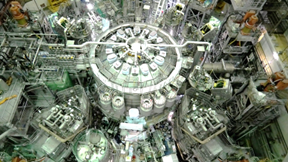


News Highlights
- Cooperation Agreement signed between F4E, QST and PPPL provides an advanced diagnostic instrument for the world’s largest tokamak JT-60SA, a joint project between Japan and Europe. This is the first contribution to JT-60SA from an institution outside of Japan and Europe.
- This partnership among these world-leading organisations will significantly contribute to accelerating fusion energy research and development, aiming for the early realisation of fusion energy for peaceful purposes.
Abstract
Fusion For Energy (Director: Marc Lachaise; hereinafter referred to as "F4E"), the National Institutes for Quantum and Science and Technology (President: Shigeo Koyasu; hereinafter referred to as "QST"), and the U.S. Department of Energy’s Princeton Plasma Physics Laboratory (Director: Steve Cowley; hereinafter referred to as "PPPL") have announced the signing of a new cooperation agreement in the field of fusion energy research and development with the participation of PPPL on the Satellite Tokamak*1 Programme JT-60SA*2 as part of the Broader Approach Activities*3, which is a joint project between Japan and Europe—and now the U.S. —aiming for the early realization of fusion energy for peaceful purposes.

JT-60SA
Under this agreement, PPPL will provide an advanced diagnostic instrument for plasma impurities in the world’s largest superconducting tokamak JT-60SA. This is the first contribution to JT-60SA from an institution outside of Japan and Europe. The instrument, known as the X-ray Imaging Crystal Spectrometer*4, was developed through cutting-edge research at PPPL to provide more precise data about the plasma than similar systems. It will generate critical information on the local ion impurity density, the ion and electron temperatures as well as the plasma flow velocity components by measuring the emissions from the plasma impurities. The information will be key in understanding and optimising impurity transport under various operational scenarios because it plays a crucial role in maintaining the overall performance. The instrument will be operational in JT-60SA during plasma heating experiments starting from 2026.
PPPL experts will participate in the experiment by operating the diagnostic instrument and sharing measured data. The exchange of scientific data will generate new knowledge among the experts in F4E, QST and PPPL, thereby accelerating the development of key technologies required for the early realization of fusion energy.
F4E, QST and PPPL have been strong contributors to international initiatives such as the ITER project*5 and their respective DEMO*6 programmes aimed at achieving commercially viable fusion energy. The new cooperation agreement on JT-60SA with a strong partnership among these institutions marks a significant step towards advancing fusion energy research globally, with the ultimate goal of delivering clean, abundant, and sustainable energy for future generations.
Glossary
*1…Tokamak
A method of confining high-temperature plasma using a magnetic field: A high-temperature plasma is confined by combining a circumferential toroidal magnetic field produced by the external coils, which is the main magnetic field, with a radial poloidal magnetic field created by passing a circumferential current in the plasma. ITER also uses a tokamak-type device.
*2…JT-60SA (JT-60 Super Advanced)
As a joint project of the satellite tokamak jointly implemented by Japan and Europe as a Broader Approach (BA) activity and the tokamak domestic priority device project that has been under consideration in Japan, the device was constructed at the QST facility in Naka City, Ibaraki Prefecture, Japan. This is the world's largest tokamak-type superconducting plasma experimental device as of today. Its purpose is to support research for ITER to achieve its technological goals and supplementary research for ITER toward DEMO reactors and human resource development. JT-60SA uses powerful superconducting coils cooled to approximately -269 degrees Celsius (absolute temperature approximately 4K) to confine plasma that can reach 100 million degrees Celsius of temperature.
URL: https://www.jt60sa.org/wp/
URL: https://www.qst.go.jp/site/jt60/5150.html (Japanese)
*3…Broader Approach Activities
The Broader Approach (BA) Agreement, concluded between the European Atomic Energy Community (Euratom) and Japan, consists of activities that aim to complement the ITER project and accelerate the development of fusion. The work includes the construction of an advanced fusion device, research into durable materials for use in future devices, and preliminary work on the future Demonstration (DEMO) reactor.
URL: https://www.ba-fusion.org/ba/
*4…X-ray Imaging Crystal Spectrometer
The X-ray Imaging Crystal Spectrometer (XICS) measures X-ray emissions by using crystal diffraction to separate and analyze the wavelengths. It detects the emitted X-rays from plasma, providing detailed information on plasma temperature and density, mainly from impurities in plasma.
*5…ITER Project
With the international cooperation of seven Parties: Japan, Europe, Russia, the United States, China, Korea, and India—the project aims to demonstrate the scientific and technological feasibility of fusion energy through the construction and operation of ITER. The target of the project is to obtain fusion energy that is 10 times larger than the input energy of the external heating system (Q≧10). Currently, the site is in Saint-Paul-les-Durance, France, and the ITER Organization, an international organization for the project implementation, is leading the construction of buildings and the assembly of components for the start of operation. Also, the manufacturing of various ITER component devices has been advanced by each of the seven parties.
*6…DEMO
A DEMO reactor is a next-generation device that will demonstrate the power generation and economic feasibility of fusion energy. Currently, conceptual designs for DEMO reactors are being developed in various countries around the world.
